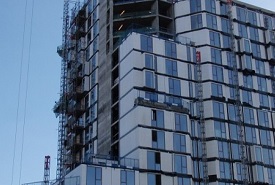Phil Bevan, AWW writes: The biggest stumbling blocks that are holding back the delivery of new inner-city housing are the availability of sites at realistic prices, lack of funding to enable developers to build, and the large deposits required by first time buyers.
Back in 2013 I commented on how off-site construction has a valuable role to play in the future of building residential and other projects, but not before more fundamental issues are resolved. Offsite construction requires a highly detailed design at an early stage. The downside is that this reduces the ability to influence the design as it progresses and if you want flexibility in the design or space planning where the programme permits, it may still be cheaper to build traditionally.
Cost and scale are one of the constraints of modular construction, repetitive design enables economies of scale but buyers don’t all want to live in uniform buildings. Urban Splash has a target to deliver up to a 1,000 a year of its own modular “hoUSe” product. HoUSe enables individuality and buy-in to the design with purchasers able to design their home off plan before seeing the finished product delivered on site. This level of customisation the opportunity to revitalise the image of modular construction.
Off-site construction may be key to allowing a construction industry facing skills shortages to grow. Off-site specialists have a permanent and highly-skilled workforce, and a robust, long-established supply chain reducing the reliance on subcontracted labour. Construction in a controlled factory environment also has the advantage of being more predictable and safer. However one of the criticisms of this is that modular construction may be carried off site in distant locations which isn’t particularly sustainable or utilise local labour.
Another exciting prospect for modular construction is the creation of on-site factories to develop housing, enabling local labour and materials to be used. The factory building would then be repurposed at the end of construction as a community building. Due to the scale of such a scheme, this would be suitable for out-of-town modular construction.
The push for modular housing by the government as a solution to the housing crisis is not new. Prefabricated houses were envisaged by Winston Churchill as a major part of the solution to address the UK’s post second world war housing shortage. Many of the properties which were only designed to last 10 years survive today, with Bristol having one of the largest and diverse remaining populations of prefab housing stock. Prefabs then were not built to last and had a reputation for not being aesthetically pleasing. It is important that in providing this next wave of building to help address the housing crisis, high design is combined with the efficiency and sustainability of modular construction.
Modular construction does have the ability to reduce timescales and may introduce economies of scale but it does not have to result in little boxes that all look the same. Architects can use modular construction to overcome the constraints of tight space requirements of inner cities whilst creating quality, inspirational design.
Written for Building by Philip Bevan, AWW director
Click HERE to see some of our works portfolio
Click HERE to visit the Ecobuild 2017 Website


